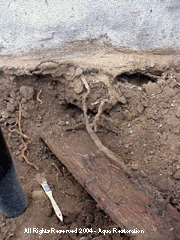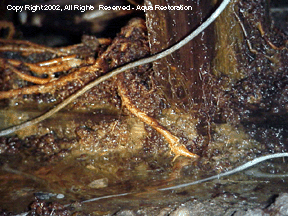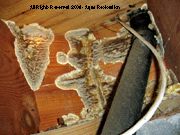 818/888-8887
818/888-8887
CA CSLB No. 798679
 Here
is the Hypha. It is secreting an enzyme onto the wood and sucking the
nutrients needed to grow like sugar and lignin.
Here
is the Hypha. It is secreting an enzyme onto the wood and sucking the
nutrients needed to grow like sugar and lignin.
Meruliporia incrassata commonly known as poria(Polyporus family)
|
|
| "The House Eating Fungus"
"It's a rare fungus, but it's as common here as anywhere in the world," said UC Riverside plant pathology professor John Menge. "It's also the most devastating wood-decaying fungus of houses that we know of". Meruliporia is one of many wood decay fungi that feeds on dead wood. It sounds like science fiction and looks like it too, but Meruliporia, like all decay fungi, is an organism that needs moisture to break down and utilize wood as a food source, according to forest product experts at UC Berkeley. But unlike other wood-decaying fungi, which tend to destroy only a six inch area around a plumbing leak or wet window sill, Meruliporia has the capacity to begin in wet soil as opposed to just damp soil. Experts say this water-conducting fungus differs from most other wood decay fungi in several respects: Large, semi-tough water-conducting roots called rhizomorphs are formed, which transport water by capillary action from a constant source (usually damp or wet soil) to dry wood in a building, wetting it sufficiently to support decay. As decay proceeds, water is conducted to dry wood adjacent to that already colonized fungi. In this manner, as long as the supply of water is available, water-conducting fungi can colonize and decay the wood to the entire structure. "In other words, because this unique fungus does not have teeth to help it eat, it has to spit on the wood and bathe in the nutrients to absorb the nutrients. And the enzyme it secretes turns the wood to mush. Any piece of wood exposed to this fungus is destroyed" says Meruliporia expert Glenn Sigmon. We used to think Meruliporia would usually start under a newly installed patio, with new landscaping or with a new room addition, and can travel far from its original water source. But that is not always the case. Wayne Wilcox, a UC Berkeley forestry professor, has found a similarity among houses with Meruliporia and the fact that major landscaping was done within 2 years of Meruliporia' onset. He speculates that the soil dumped on these suburban lawns originated in various forests around the world, where Meruliporia occurs naturally and helps in the process of decomposition, and he feels Meruliporia may have come along for the ride. Donna Kingwell, a spokeswoman for the California state's Structural Pest Control Board, said "the agency is keenly aware of the potent problems of Meruliporia, especially in the southern part of California". First reports of Meruliporia incrassata destruction surfaced in 1913 in the southeastern United States, where forest products were the suspected origin of the fungus-abound. There is no record of the first reported case of Meruliporia in California, according to Wayne Wilcox, a UC Berkeley forestry professor, but scientists discovered the telltale spores on three coastal redwoods in 1924. Infestations of Meruliporia are rare. Only 15 cases were reported state wide by 1968, according to a U.S. Department of Agriculture study. "When Meruliporia does invade a house, it's almost always catastrophic", said Mississippi State University wood technology professor Terry Amburgey. "The fungus will infiltrate a foundation, wood or concrete, and pretty soon the entire house goes". Poria has an appetite not only for common construction woods such as oak and pine, but for cedar, redwood, cypress and juniper that are naturally decay-resistant. In addition to attacking most woods classed as naturally decay resistant, laboratory tests show that Meruliporia is resistant to many fungicides containing copper. The practical significance of this tolerance is uncertain, but no failures of wood treated with copper fungicides have been reported in buildings to date. When Meruliporia attacks a building, spectacular damage often results once well established it can destroy large areas of floors and walls every year or so. Fortunately, control is relatively simple, i.e. the permanent elimination of the water source. Although Meruliporia is relatively rare, the rapid and extensive damage it can cause makes it desirable to understand the conditions leading to the attract, the signs indicating an attack is in progress, and methods of prevention and control of an attack. Control and Remediation Earlier control recommendations called for the removal of decayed wood and all sound wood within 2 feet of obvious visible growth on the assumption that Meruliporia, once established, can decay wood with metabolic water as the sole source of moisture. Poria Incrassata is more sensitive to higher temperatures than most decaying fungi and is killed in moist wood at temperatures only moderately above "air-temperature maxima". This explains why Meruliporia occurs in the more protected parts of structure and not in wood exposed to full sun. In other words, Meruliporia is extremely sensitive to drying. In naturally infected wood, it can survive only 32 days of air drying. In laboratory tests, all artificial infections were dead in 1 day at 10% RH (relative humidity), 5 days at 65%, and 10 days at 90%. Sensitivity to drying, in conjunction with the need for conducted-water, forms the basis for the presently recommended simplified control and remediation measures. Call us at Aqua Restoration at 818/888-8887 for an estimate on the removal and to keep it from coming back.
|
|
 These
rhizomorphs are coming from a piece of wood found two feet out and two
feet under the soil. They then sent a runner root out and it happened to
find the bottom of the foundation, and then went up into the crawl space
and then the floor joists and that's all it needed.
These
rhizomorphs are coming from a piece of wood found two feet out and two
feet under the soil. They then sent a runner root out and it happened to
find the bottom of the foundation, and then went up into the crawl space
and then the floor joists and that's all it needed.

 We
found the main rhizomorphs (stem root) coming into the house. They
resemble a soft rope and smells like soil and mushroom from the store.
We
found the main rhizomorphs (stem root) coming into the house. They
resemble a soft rope and smells like soil and mushroom from the store.

 Here
you can see spore settlement on personal contents in the garage. Brown
powdery spores will start to show up on flat surfaces when the fruiting
bodies start to sporulate and send these seeds into the air.
Here
you can see spore settlement on personal contents in the garage. Brown
powdery spores will start to show up on flat surfaces when the fruiting
bodies start to sporulate and send these seeds into the air.

 See
the brown spider-web looking substance? Well that is the fruiting bodies
and characteristic of poria.
See
the brown spider-web looking substance? Well that is the fruiting bodies
and characteristic of poria.

 You
can see how it flows over the wood. Again this is the fruiting body and
not the Hypha or rhizomes. This is the growing end of the organism.
You
can see how it flows over the wood. Again this is the fruiting body and
not the Hypha or rhizomes. This is the growing end of the organism.

 It
resembles orange pancake batter. While you dip your finger in the pancake
batter on Sunday morning, it is dripping it's batter onto your house... to
eat.
It
resembles orange pancake batter. While you dip your finger in the pancake
batter on Sunday morning, it is dripping it's batter onto your house... to
eat.

 This
is a very fast growing fungus and can consume a large area of
substructure before you start to notice it coming up from the baseboards
and door jams.
This
is a very fast growing fungus and can consume a large area of
substructure before you start to notice it coming up from the baseboards
and door jams.

 It
may even look like several infestations but it is usually only one
organism growing from all directions. If given full rain, it has been
known to consume and destroy a whole house in less then one year.
It
may even look like several infestations but it is usually only one
organism growing from all directions. If given full rain, it has been
known to consume and destroy a whole house in less then one year.
 This
fungus is very opportunistic. It will grow in some of the more
undesirable spaces in your home. This is starting to ooz out from the
door jams of this Sherman Oaks, CA house.
This
fungus is very opportunistic. It will grow in some of the more
undesirable spaces in your home. This is starting to ooz out from the
door jams of this Sherman Oaks, CA house.

